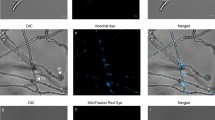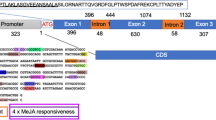Abstract
Plant lipoxygenases (LOXs) are key enzymes involved in the generation of fatty acid derivatives, called oxylipins. In tobacco, LOX gene expression and activity are very low in healthy tissues and are highly enhanced in response to infection by Phytophthora parasitica nicotianae and to elicitor treatment. We previously showed, using antisense-LOX1 plants, that expression of the tobacco LOX1 gene is required for the race-cultivar specific resistance of tobacco to Phytophthora parasitica nicotianae. In order to investigate the effect of over-expressing a LOX gene on plant resistance, we transformed tobacco plants with the LOX1 coding sequence fused to the CaMV 35S promoter. Four transgenic lines with enhanced levels of LOX protein and specific activity over control plants were selected for further analysis. These plants were macroscopically indistinguishable from WT plants. Upon stem inoculation, the sense-LOX1 plants displayed a significantly decreased susceptibility to virulent races of Phytophthora parasitica nicotianae, stem lesions being 2- to 3-fold shorter in the transgenic lines than in WT plants. Using a root inoculation assay, the survival rate of sense-LOX1 seedlings was increased about 4-fold compared to their WT counterparts, with 60 to 80% of transgenic plants vs 15 to 20% of WT controls remaining healthy following inoculation with Phytophthora parasitica nicotianae. This is the first demonstration that the over-expression of a LOX gene is sufficient to reduce the susceptibility of a host plant to an oomycete pathogen.
Similar content being viewed by others
References
Blée E. 1998. Phytooxylipins and plant defense reactions. Prog Lipid Res 37: 33–72.
Bostock R.M., Kuc J.A. and Laine R.A. 1981. Eicosapentaenoic and arachidonic acids from Phytophthora infestans elicit fungitoxic sesquiterpenes in the potato. Science 212: 67–69.
Bradford M.M. 1976. A rapid and sensitive method for the quantitation of microgram quantities of protein utilizing the principle of protein-dye binding. Anal Biochem 72: 248–254.
Caldelari D. and Farmer E.E. 1998. A rapid assay for the coupled cell free generation of oxylipins. Phytochemistry 47: 599–604.
Creelman R.A. and Mullet J.E. 1997. Biosynthesis and action of jasmonates in plants. Annu. Rev. Plant Physiol. Plant Mol. Biol. 48: 355–381.
Dellaporta S.L., Wood J. and Hicks J.B. 1983. A plant DNA minipreparation: version II. Plant Mol. Biol. Rep. 1: 19–21.
Deng W., Grayburn W.S., Hamilton-Kemp T.R., Collins G.B. and Hildebrand D.F. 1992. Expression of soybean-embryo lipoxygenase 2 in transgenic tobacco tissue. Planta 187: 203–208.
Dhondt S., Geoffroy P., Stelmach B.A., Legrand M. and Heitz T. 2000. Soluble phospholipase A2 activity is induced before oxylipin accumulation in tobacco mosaic virus-infected tobacco leaves and is contributed by patatin-like enzymes. Plant J. 23: 431–440.
Elfstrand M., Sitbon F., Lapierre C., Bottin A. and von Arnold S. 2002. Altered lignin structure and resistance to pathogens in spi 2-expressing tobacco plants. Planta 214: 708–716.
Farmer E.E. 1994. Fatty acid signalling in plants and their associated microorganisms. Plant Mol. Biol. 26: 1423–1437.
Feussner I. and Wasternack C. 2002. The Lipoxygenase Pathway. Annu. Rev. Plant Biol. 53: 275–297.
Fournier J., Pouénat M.L., Rickauer M., Rabinovitch-Chable H., Rigaud M. and Esquerré-Tugayé M.T. 1993. Purification and characterization of elicitor-induced lipoxygenase in tobacco cells. Plant J 3: 63–70.
Göbel C., Feussner I., Schmidt A., Scheel D., Sanchez-Serrano J., Hamberg M. et al. 2001. Oxylipin profiling reveals the preferential stimulation of the 9-lipoxygenase pathway in elicitortreated potato cells. J. Biol. Chem. 276: 6267–6273.
Grechkin A. 1998. Recent developments in biochemistry of the plant lipoxygenase pathway. Prog. Lipid Res. 37: 317–352.
Hause B., Weichert H., Hohne M., Kindl H. and Feussner I. 2000. Expression of cucumber lipid-body lipoxygenase in transgenic tobacco: lipid-body lipoxygenase is correctly targeted to seed lipid bodies. Planta 210: 708–714.
Helgeson J.P., Kemp J.D., Haberlach G.T. and Maxwell D.P. 1972. A tissue culture system for studying disease resistance: the black shank disease in tobacco callus culture. Phytopathology 62: 1439–1443.
Hendrix J.W. and Apple J.L. 1967. Stem resistance to Phytophthora parasitica var. nicotianae in tobacco derived from Nicotiana longiflora and Nicotiana plumbaginifolia. Tob. Sci. 11: 148–150.
Howe GA., Lightner J., Browse J. and Ryan C.A. 1996. An octadecanoid pathway mutant (JL5) of tomato is compromised in signaling for defense against insect attack. Plant Cell 8: 2067–2077.
Howe G.A. and Schilmiller A.L. 2002. Oxylipin metabolism in response to stress. Curr. Opin. Plant Biol. 5: 230–236.
Kato T., Yamaguchi Y., Hirano T., Yokoyama T., Uyehara T., Namai T. et al. 1984. Unsaturated hydroxy fatty acids, the self defensive substance in rice plant against rice blast disease. Chem. Lett. 409-412.
Keen N.T. 1975. Specific elicitors of plant phytoalexin production: determinants of race specificity in pathogens? Science 187: 74–75.
Knight V.I., Wang H., Lincoln J.E., Lulai E.C., Gilchrist D.G. and Bostock R.M. 2001. Hydroperoxides of fatty acids induce programmed cell death in tomato protoplasts. Physiol. Mol. Plant Pathol. 59: 277–286.
Koch E., Meier B.M., Eiben H.G. and Slusarenko A.J. 1992. A lipoxygenase from leaves of tomato (Lycopersicum esculentum Mill) is induced in response to plant pathogenic Pseudomonads. Plant Physiol. 99: 571–576.
Kolomiets M.V., Chen H., Gladon R.J., Braun E.J. and Hannapel D.J. 2000. A leaf lipoxygenase of potato induced specifically by pathogen infection. Plant Physiol. 124: 1121–1130.
Kühn H., Belkner J., Wiesner R. and Alder L. 1990. Occurrence of 9-and 13-keto-octadecadienoic acid in biological membranes oxygenated by the reticulocyte lipoxygenase. Arch. Biochem. Biophys. 279: 218–224.
Maccarrone M., van Aarle P.G., Veldink G.A. and Vliegenthart J.F. 1994. In vitro oxygenation of soybean biomembranes by lipoxygenase-2. Biochim. Biophys. Acta. 1190: 164–169.
Matsui K., Nishioka M., Ikeyoshi M., Matsumura Y., Mori T. and Kajiwara T. 1998. Cucumber root lipoxygenase can act on acyl groups in phosphatidylcholine. Biochim. Biophys. Acta. 1390: 8–20.
McConn M., Creelman R.A., Bell E., Mullet J.E. and Browse J. 1997. Jasmonate is essential for insect defense in Arabidopsis. Proc. Natl. Acad. Sci. U. S. A. 94: 5473–5477.
Namai T., Kato T., Yamaguchi Y. and Hirukawa T. 1993. Anti-rice blast activity and resistance induction of C-18 oxygenated fatty acids. Biosci. Biotechnol. Biochem. 57: 611–613.
Noordermeer M.A., Veldink G.A. and Vliegenthart J.F. 2001. Fatty acid hydroperoxide lyase: a plant cytochrome P450 enzyme involved in wound healing and pest resistance. Chembiochem. 2: 494–504.
Peng Y.L., Shirano Y., Ohta H., Hibino T., Tanaka K. and Shibata D. 1994. A novel lipoxygenase from rice. Primary structure and specific expression upon incompatible infection with rice blast fungus. J. Biol. Chem. 269: 3755–3761.
Preisig C. and Kuc J.A. 1985. Arachidonic acid-related elicitors of the hypersensitive response in potato and enhancement of their activities by glucans from Phytophthora infestans (Mont.) deBarry. Arch. Biochem. Biophys. 236: 379–389.
Rancé I., Fournier J. and Esquerré-Tugayé M.T. 1998. The incompatible interaction between Phytophthora parasitica var. nicotianae race 0 and tobacco is suppressed in transgenic plants expressing antisense lipoxygenase sequences. Proc. Natl. Acad. Sci. U. S. A. 95: 6554–6559.
Rickauer M., Brodschelm W., Bottin A., Véronési C., Grimal H. and Esquerré-Tugayé M.T. 1997. The jasmonate pathway is involved differentially in the regulation of different defence responses in tobacco cells. Planta 202: 155–162.
Rosahl S. 1996. Lipoxygenases in plants - their role in development and stress response. Z. Naturforsch [C] 51: 123–138.
Roy S., Pouenat M.-L., Caumont C., Cariven C., Prevost M.-C. and Esquerré-Tugayé M.-T. 1995. Phospholipase activity and phospholipid patterns in tobacco cells treated with fungal elicitor. Plant Sci. 107: 17–25.
Royo J., Leon J., Vancanneyt G., Albar J.P., Rosahl S. and Ortego F. et al. 1999. Antisense-mediated depletion of a potato lipoxygenase reduces wound induction of proteinase inhibitors and increases weight gain of insect pests. Proc. Natl. Acad. Sci. U. S. A. 96: 1146–1151.
Rustérucci C., Montillet J.L., Agnel J.P., Battesti C., Alonso B. and Knoll A. et al. 1999. Involvement of lipoxygenase-dependent production of fatty acid hydroperoxides in the development of the hypersensitive cell death induced by cryptogein on tobacco leaves. J. Biol. Chem. 274: 36446–36455.
Sambrook J., Fritsh E.F. and Maniatis T. 1989. Molecular cloning: a laboratory manual. Cold Spring Harbor Laboratory Press, New-York.
Seo H.S., Song J.T., Cheong J.J., Lee Y.H., Lee Y.W. and Hwang I. et al. 2001. Jasmonic acid carboxyl methyltransferase: a key enzyme for jasmonate-regulated plant responses. Proc. Natl. Acad. Sci. U. S. A. 98: 4788–4793.
Shibata D., Slusarenko A.J., Casey R., Hildebrand D. and Bell E. 1994. Lipoxygenases. Plant Mol. Biol. Rep. 12: S41-S42.
Slusarenko A.J. 1996. The role of lipoxygenase in resistance of plants to infection. In: Piazza G.J. (ed.), Lipoxygenase and lipoxygenase pathway enzymes, AOCS Press, Champain, Illinois, pp. 176–197.
Staswick P.E., Yuen G.Y. and Lehman C.C. 1998. Jasmonate signaling mutants of Arabidopsis are susceptible to the soil fungus Pythium irregulare. Plant J. 15: 747–754.
Véronési C., Fournier J., Rickauer M., Marolda M. and Esquerré-Tugayé M.T. 1995. Nucleotide sequence of an elicitor-induced tobacco lipoxygenase cDNA (Genbank X84040). Plant Physiol. 108: 1342.
Véronési C., Rickauer M., Fournier J., Pouénat M.L. and Esquerré-Tugayé M.T. 1996. Lipoxygenase gene expression in the tobacco-Phytophthora parasitica nicotianae interaction. Plant Physiol. 112: 997–1004.
Vijayan P., Shockey J., Levesque C.A., Cook R.J. and Browse J. 1998. A role for jasmonate in pathogen defense of Arabidopsis. Proc. Natl. Acad. Sci. U. S. A. 95: 7209–7214.
Villalba Mateos F., Rickauer M. and Esquerré-Tugayé M.T. 1997. Cloning and characterization of a cDNA encoding an elicitor of Phytophthora parasitica var. nicotianae that shows cellulosebinding and lectin-like activities. Mol. Plant Microbe Interact. 10: 1045–1053.
Vollenweider S., Weber H., Stolz S., Chetelat A. and Farmer E.E. 2000. Fatty acid ketodienes and fatty acid ketotrienes: Michael addition acceptors that accumulate in wounded and diseased Arabidopsis leaves. Plant J. 24: 467–476.
Weber H., Vick B.A. and Farmer E.E. 1997. Dinor-oxo-phytodienoic acid: a new hexadecanoid signal in the jasmonate family. Proc. Natl. Acad. Sci. U. S. A. 94: 10473–10478.
Weber H., Chetelat A., Caldelari D. and Farmer E.E. 1999. Divinyl ether fatty acid synthesis in late blight-diseased potato leaves. Plant Cell 11: 485–494.
Author information
Authors and Affiliations
Rights and permissions
About this article
Cite this article
Mène-Saffrané, L., Esquerré-Tugayé, MT. & Fournier, J. Constitutive expression of an inducible lipoxygenase in transgenic tobacco decreases susceptibility to Phytophthora parasitica var. nicotianae . Molecular Breeding 12, 271–282 (2003). https://doi.org/10.1023/B:MOLB.0000006754.19398.d4
Issue Date:
DOI: https://doi.org/10.1023/B:MOLB.0000006754.19398.d4




